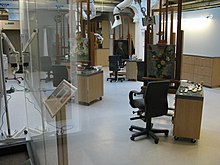Conservation (art)
Conservation, also known as conservation and restoration, is a job where people try to protect the important parts of a culture for the future.

Conservation activities include examination, documentation, treatment, protection. All of this work is supported by research and education.
Definition
changeIn traditional terms, the role of the conservator involves the examination, conservation, and preservation of cultural heritage using "any methods that prove effective in keeping that property in as close to its original condition as possible for as long as possible."[1]
The role of conservation is a kind stewardship.
The conservator has ethical guidelines, including
- Minimal intervention
- Materials and methods which can be undone if necessary
- Full documentation of all work
An appropriate conservation strategy requires good judgment, taking into account
- the views of the owner of the object
- the heritage value and meaning of the object
- the physical needs of the material
Gallery
changeThis series of images shows the process of restoration of a mural in France.
-
First archaeological search in the 19th century layer -
Re-painting of the 15th century image before restoration -
Image after restoration
References
change- ↑ Walston, S., "The Preservation and Conservation of Aboriginal and Pacific Cultural Material in Australian Museums," ICCM Bulletin (Institute for the Conservation of Cultural Materials), Vol. 4, No. 1, December 1978. p. 9.
Other websites
change- Metropolitan Museum of Art, What is Art Conservation?
- Liverpool Museum, Agents of Deterioration